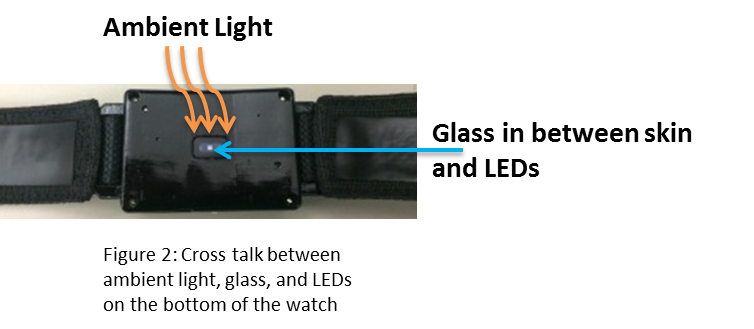SSZTCA6 August 2015 AFE4404
You don’t need to look too hard to find complaints about the accuracy of optical heart-rate smart watches. Many technology blog reviews stated that you’ll benefit from its activity and sleep-tracking functions rather than the optical heart-rate monitor to achieve your health and fitness goals.
When optical heart-rate technology was first introduced, accuracy issues seemed to put a damper on the significance of this technology in being able to improve health and fitness for many consumers. The reason the accuracy of the optical heart-rate readings were so far off was because our human anatomy puts forth several significant challenges.
For an optical heart-rate monitor to work, an accurate AC reading from the photodiode is necessary. However, it is very difficult to get a reading of the AC since there is so much DC output from outside the system. DC offset correction gives you the ability to read the AC waveform with minimal performance issues from the DC output. The way this technology works is that an offset subtraction digital-to-analog converter (DAC) eliminates any DC noise coming from sources like ambient light. There is also some correction needed from the DC noise coming from the skin and arteries. With this offset subtraction DAC, you can get a better reading of the AC waveform and amplify the remaining signal for high gain and more accuracy, as shown in Figure 1.
 Figure 1 DC Offset Correction for
Higher Gain
Figure 1 DC Offset Correction for
Higher GainAnother problem of early optical heart-rate watch models was that sweat or any kind of wetness on the skin caused inaccurate readings, severely limiting the watch’s efficiency. The solution was to place a piece of glass in-between the watch’s light-emitting diodes (LEDs) and the skin to isolate the wetness. However, the reflection from the glass between the skin and the LEDs led to crosstalk, again creating noise inaccuracies in the heart-rate readings, as shown in Figure 2.
 Figure 2 Crosstalk between Ambient
Light, Glass and LEDs on the Bottom of a Smart Watch
Figure 2 Crosstalk between Ambient
Light, Glass and LEDs on the Bottom of a Smart WatchIn a study case done in the TI lab, we tested a watch design with no glass barrier and no DC correction in place and measured an AC output of 3.5mV. When we added just the glass, the AC output went down to 2mV and was sometimes unattainable. Finally, we introduced TI’s AFE4404 analog front end (AFE) for wearable, optical heart-rate monitoring and bio-sensing. The AFE4404 offers a feature for DC offset correction that mitigates crosstalk through its ability to isolate important AC signals from the DC noise. In our last test, we measured an AC output of 15mV, close to five times better than first case and seven times better than the second case.
Offset-correction technology solves several accuracy issues in optical heart-rate designs and improves the performance of optical heart-rate smart watches. With this technology from TI, we expect users will be a lot happier with their optical heart-rate technology!
Additional Resources
- View the AFE4404 datasheet.
- Check out TI’s medical AFE portfolio.